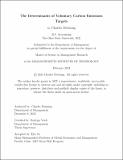| dc.contributor.advisor | Verdi, Rodrigo | |
| dc.contributor.author | Downing, Charles | |
| dc.date.accessioned | 2024-03-13T13:31:04Z | |
| dc.date.available | 2024-03-13T13:31:04Z | |
| dc.date.issued | 2024-02 | |
| dc.date.submitted | 2024-02-02T16:16:46.158Z | |
| dc.identifier.uri | https://hdl.handle.net/1721.1/153742 | |
| dc.description.abstract | This study seeks to examine whether and how firms near important emissions thresholds change their behavior to meet these targets. Emissions targets are commonly measured in two ways: absolute emissions levels and emissions intensity(absolute levels normalized by sales). To meet absolute benchmarks, firms can only reduce their actual emissions. However, to meet intensity-based benchmarks, firms can either lower their emissions or raise revenue to meet their goal. This study will characterize the differences between firms who choose these two measurements, and investigate whether and when firms shift their emissions or reporting behavior to meet their emissions targets. Furthermore, this study will characterize the capital market consequences of meeting or missing emissions targets, consider potential market-based benchmarks in addition to targets set by the firms, and test cross-sectionally when firms have stronger incentives or ability to react to these targets. | |
| dc.publisher | Massachusetts Institute of Technology | |
| dc.rights | In Copyright - Educational Use Permitted | |
| dc.rights | Copyright retained by author(s) | |
| dc.rights.uri | https://rightsstatements.org/page/InC-EDU/1.0/ | |
| dc.title | The Determinants of Voluntary Carbon Emissions Targets | |
| dc.type | Thesis | |
| dc.description.degree | S.M. | |
| dc.contributor.department | Sloan School of Management | |
| dc.identifier.orcid | 0009-0002-9877-8197 | |
| mit.thesis.degree | Master | |
| thesis.degree.name | Master of Science in Management Research | |
